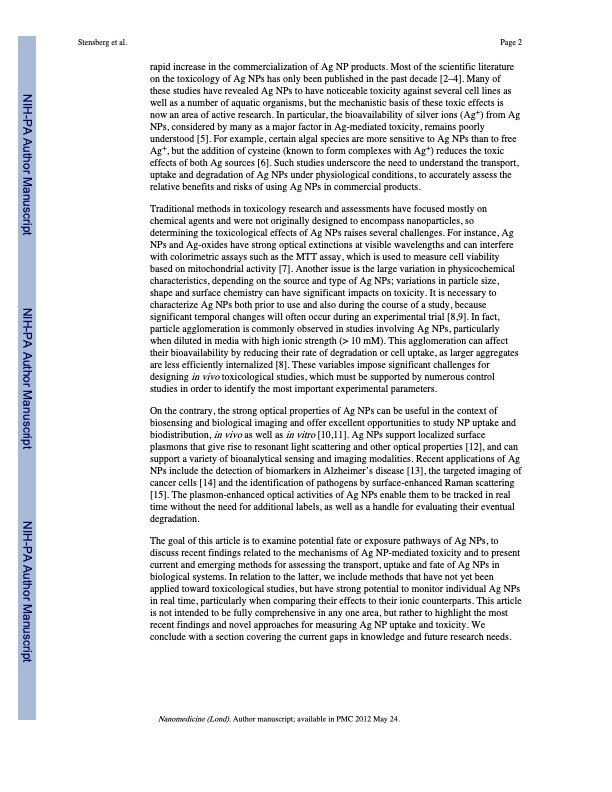
PDF Publication Title:
Text from PDF Page: 002
Stensberg et al. Page 2 rapid increase in the commercialization of Ag NP products. Most of the scientific literature on the toxicology of Ag NPs has only been published in the past decade [2–4]. Many of these studies have revealed Ag NPs to have noticeable toxicity against several cell lines as well as a number of aquatic organisms, but the mechanistic basis of these toxic effects is now an area of active research. In particular, the bioavailability of silver ions (Ag+) from Ag NPs, considered by many as a major factor in Ag-mediated toxicity, remains poorly understood [5]. For example, certain algal species are more sensitive to Ag NPs than to free Ag+, but the addition of cysteine (known to form complexes with Ag+) reduces the toxic effects of both Ag sources [6]. Such studies underscore the need to understand the transport, uptake and degradation of Ag NPs under physiological conditions, to accurately assess the relative benefits and risks of using Ag NPs in commercial products. Traditional methods in toxicology research and assessments have focused mostly on chemical agents and were not originally designed to encompass nanoparticles, so determining the toxicological effects of Ag NPs raises several challenges. For instance, Ag NPs and Ag-oxides have strong optical extinctions at visible wavelengths and can interfere with colorimetric assays such as the MTT assay, which is used to measure cell viability based on mitochondrial activity [7]. Another issue is the large variation in physicochemical characteristics, depending on the source and type of Ag NPs; variations in particle size, shape and surface chemistry can have significant impacts on toxicity. It is necessary to characterize Ag NPs both prior to use and also during the course of a study, because significant temporal changes will often occur during an experimental trial [8,9]. In fact, particle agglomeration is commonly observed in studies involving Ag NPs, particularly when diluted in media with high ionic strength (> 10 mM). This agglomeration can affect their bioavailability by reducing their rate of degradation or cell uptake, as larger aggregates are less efficiently internalized [8]. These variables impose significant challenges for designing in vivo toxicological studies, which must be supported by numerous control studies in order to identify the most important experimental parameters. On the contrary, the strong optical properties of Ag NPs can be useful in the context of biosensing and biological imaging and offer excellent opportunities to study NP uptake and biodistribution, in vivo as well as in vitro [10,11]. Ag NPs support localized surface plasmons that give rise to resonant light scattering and other optical properties [12], and can support a variety of bioanalytical sensing and imaging modalities. Recent applications of Ag NPs include the detection of biomarkers in Alzheimer’s disease [13], the targeted imaging of cancer cells [14] and the identification of pathogens by surface-enhanced Raman scattering [15]. The plasmon-enhanced optical activities of Ag NPs enable them to be tracked in real time without the need for additional labels, as well as a handle for evaluating their eventual degradation. The goal of this article is to examine potential fate or exposure pathways of Ag NPs, to discuss recent findings related to the mechanisms of Ag NP-mediated toxicity and to present current and emerging methods for assessing the transport, uptake and fate of Ag NPs in biological systems. In relation to the latter, we include methods that have not yet been applied toward toxicological studies, but have strong potential to monitor individual Ag NPs in real time, particularly when comparing their effects to their ionic counterparts. This article is not intended to be fully comprehensive in any one area, but rather to highlight the most recent findings and novel approaches for measuring Ag NP uptake and toxicity. We conclude with a section covering the current gaps in knowledge and future research needs. Nanomedicine (Lond). Author manuscript; available in PMC 2012 May 24. NIH-PA Author Manuscript NIH-PA Author Manuscript NIH-PA Author ManuscriptPDF Image | Toxicological studies on silver nanoparticles

PDF Search Title:
Toxicological studies on silver nanoparticlesOriginal File Name Searched:
nihms-316964.pdfDIY PDF Search: Google It | Yahoo | Bing
Turbine and System Plans CAD CAM: Special for this month, any plans are $10,000 for complete Cad/Cam blueprints. License is for one build. Try before you buy a production license. More Info
Waste Heat Power Technology: Organic Rankine Cycle uses waste heat to make electricity, shaft horsepower and cooling. More Info
All Turbine and System Products: Infinity Turbine ORD systems, turbine generator sets, build plans and more to use your waste heat from 30C to 100C. More Info
CO2 Phase Change Demonstrator: CO2 goes supercritical at 30 C. This is a experimental platform which you can use to demonstrate phase change with low heat. Includes integration area for small CO2 turbine, static generator, and more. This can also be used for a GTL Gas to Liquids experimental platform. More Info
Introducing the Infinity Turbine Products Infinity Turbine develops and builds systems for making power from waste heat. It also is working on innovative strategies for storing, making, and deploying energy. More Info
Need Strategy? Use our Consulting and analyst services Infinity Turbine LLC is pleased to announce its consulting and analyst services. We have worked in the renewable energy industry as a researcher, developing sales and markets, along with may inventions and innovations. More Info
Made in USA with Global Energy Millennial Web Engine These pages were made with the Global Energy Web PDF Engine using Filemaker (Claris) software.
Infinity Turbine Developing Spinning Disc Reactor SDR or Spinning Disc Reactors reduce processing time for liquid production of Silver Nanoparticles.
| CONTACT TEL: 608-238-6001 Email: greg@infinityturbine.com | RSS | AMP |